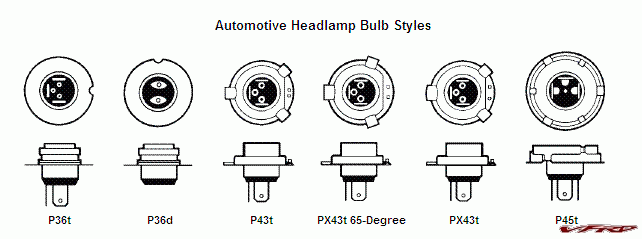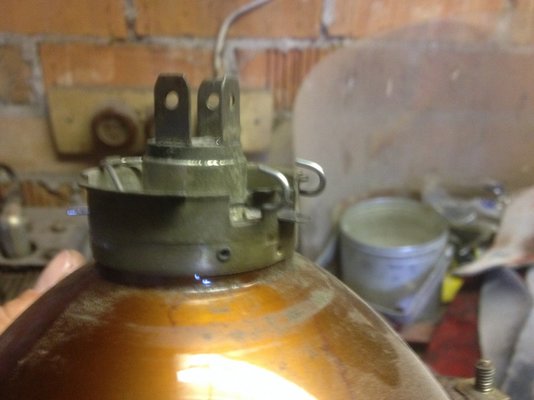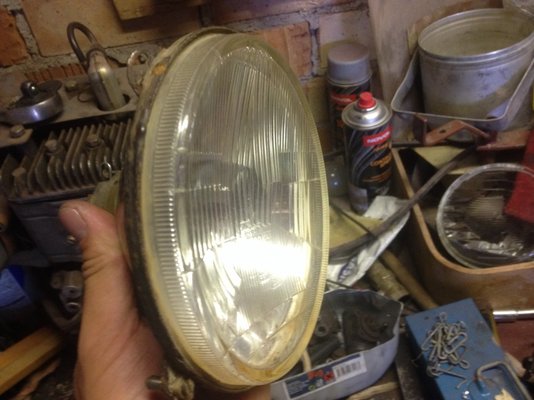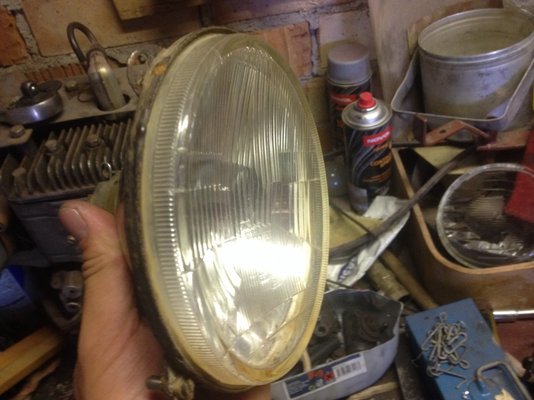You are using an out of date browser. It may not display this or other websites correctly.
You should upgrade or use an alternative browser.
You should upgrade or use an alternative browser.
Headlights
- Thread starter Ignas
- Start date
https://www.franzose.de/en/Renault/R4/Scheinwerfer-Zubehoer-Halterungen/ANR85073/ And what about this. What kind of bulbs goes in there?
petak
Enthusiast
- Messages
- 1,882
- Location
- Vodice, Croatia
https://www.franzose.de/en/Renault/R4/Scheinwerfer-Zubehoer-Halterungen/ANR85073/ And what about this. What kind of bulbs goes in there?
There goes bulb with P45t bottom base
You can fit two bulbs
1. older (original) R2 bulb with P45t base
http://www.autobulbsdirect.co.uk/410-P45t-Headlamp-45-40W-Older-type-H4-fitting.html
2. modern H4 light with P45t base (also named H5)
http://www.conrad.com/ce/en/product/846821/OSRAM-64183-01B-R2-Bulb-P45t-12V
retrospecparts
Enthusiast
- Messages
- 212
- Location
- West Sussex
You don't need to pay anywhere near that much!There goes bulb with P45t bottom base
You can fit two bulbs
1. older (original) R2 bulb with P45t base
http://www.autobulbsdirect.co.uk/410-P45t-Headlamp-45-40W-Older-type-H4-fitting.html
2. modern H4 light with P45t base (also named H5)
http://www.conrad.com/ce/en/product/846821/OSRAM-64183-01B-R2-Bulb-P45t-12V
mr-reno-139
AKA Paul Cunningham
- Messages
- 2,247
- Location
- lancing west sussex england
Seen adapter rings to fit the later halogen bulbs to round holes on ebay too
petak
Enthusiast
- Messages
- 1,882
- Location
- Vodice, Croatia
Thank you retrospecparts.....my mistake for not pointing out that links are just to show difference in two bulbs.....Believe that in Lithuania are car parts shops were bulbs can be bought much cheaper.
Mr-reno-139....have those adapters for "normal" H4 bulbs with P43t base but had to adapt them to fit my headlights, and spotted small "problem"
As you put adapters, that are 3-4mm thick, then focus of the bulb is 3-4mm out of headlight lens focus and you have big round black spot in center of illuminated part of road.
That is why H5 bulb (H4 bulb with P45t base) is better solution....still adapters can work if you are not driving to much in the dark
Here is one internet photo of different bases,

Mr-reno-139....have those adapters for "normal" H4 bulbs with P43t base but had to adapt them to fit my headlights, and spotted small "problem"
As you put adapters, that are 3-4mm thick, then focus of the bulb is 3-4mm out of headlight lens focus and you have big round black spot in center of illuminated part of road.
That is why H5 bulb (H4 bulb with P45t base) is better solution....still adapters can work if you are not driving to much in the dark
Here is one internet photo of different bases,

retrospecparts
Enthusiast
- Messages
- 212
- Location
- West Sussex
I've been selling 412 / HB12 bulbs for years and didn't realise that they are also called 'H5'. (I've got yellow ones as well, if you want the classic the French look).
Paul Narramore
pre-moderated
- Messages
- 840
- Location
- Aylesford, Kent
I've been selling 412 / HB12 bulbs for years and didn't realise that they are also called 'H5'. (I've got yellow ones as well, if you want the classic the French look).
I have just been reading up about the numerous headlight bulbs available, and even gone out to the workshop to dig out any spares I had. I have to say it's made my head spin with all of the variations. I've even got a couple of 130/110w halogen bulbs which would suit a rally car!
I'm pretty sure that my bulbs - I have looked and there's no inscription to say that they are P45t filament bulbs - are the bog standard 45/40W types. I want to go up in power but would like yellow, partly because yellow bulbs are slightly poorer on country roads. Some here may disagree but my BMW R100GS-PD motorcycle has a yellow headlight protector and is does cut down the light effectiveness.
So more power(halogen), and yellow would be attractive. What do you suggest please?
(Later) I have just looked at your website and you sell 45/40w yellow filament bulbs and 55/60w halogen bulbs (both yellow). I presume the yellow 'cover' on the halogen bulb reduces it's effectiveness to that of the bog standard 45/40w?
André4Renaults
Enthusiast
- Messages
- 709
- Location
- Barnet, Hertfordshire.
I hope the following will help...
The headlights fitted to continental European cars in the 1960s & early 1970s (NOT most British cars, which used sealed beam lights at that time) were non-halogen 45/40 watt bulbs. The fitting on the bulbs were a circular fitting, which ensured the bulb could only be fitted one way, ensuring the beam pattern on dipped beam was correct for the side of the road the car was being driven on. Some manufacturers, including Renault (and Daf, oddly!) fitted their lights with a catch which enabled the beams to be changed for the other side of the road.
Fast forward to the mid-late 1970s and sealed beams were out and halogen headlights were in! To distinguish these bulbs from the older ones the fittings were different, with halogen bulbs having 3 distinct prongs emanating from a smaller circular fitting; again, these 3 prongs ensured the bulbs could not be incorrectly fitted.
Some owners of older cars wanted the brighter halogen bulbs in their cars, but didn't want/couldn't fit the newer headlamp units to their cars. To deal with this the light manufacturers came up with the P43 bulb, which was a halogen bulb with a non-halogen fitting, thus allowing older cars to benefit from the brighter halogen bulbs. Again, those cars with a facility to allow the dipped beam to be altered could do so with these bulbs. The original reason for not allowing them to be fitted to older cars was that these older cars had dynamos and halogen bulbs used more current; OK for alternator-powered cars, but not so good for dynamo-powered ones sitting in traffic jams!
Yellow headlamp bulbs (so-called "French style" headlamps) were manufactured by lamp companies for sale to French car companies and were also sold to drivers travelling to France on holiday (those with sealed beam lights had to fit those yellow covers the size of saucers-remember them?) The yellow colour used is specifically defined as "selective yellow" and is NOT just any yellow colour. Clip-on covers are available to snap over the halogen bulbs (they attach to the metal lip at the base of the glass part of the bulb) and give that distinctive (and perfectly legal!) yellow light.
I've used nothing but yellow headlights in all my cars, both British and non-British and am confident driving with them in all conditions. what started as a "bit of a joke" when France was ordered by the E.U. to stop using yellow headlights (I was working in France at the time & picked up dozens [or was it hundreds?] of them for a song!) has developed into an almost cottage industry of advice, selling and fitting them!
The headlights fitted to continental European cars in the 1960s & early 1970s (NOT most British cars, which used sealed beam lights at that time) were non-halogen 45/40 watt bulbs. The fitting on the bulbs were a circular fitting, which ensured the bulb could only be fitted one way, ensuring the beam pattern on dipped beam was correct for the side of the road the car was being driven on. Some manufacturers, including Renault (and Daf, oddly!) fitted their lights with a catch which enabled the beams to be changed for the other side of the road.
Fast forward to the mid-late 1970s and sealed beams were out and halogen headlights were in! To distinguish these bulbs from the older ones the fittings were different, with halogen bulbs having 3 distinct prongs emanating from a smaller circular fitting; again, these 3 prongs ensured the bulbs could not be incorrectly fitted.
Some owners of older cars wanted the brighter halogen bulbs in their cars, but didn't want/couldn't fit the newer headlamp units to their cars. To deal with this the light manufacturers came up with the P43 bulb, which was a halogen bulb with a non-halogen fitting, thus allowing older cars to benefit from the brighter halogen bulbs. Again, those cars with a facility to allow the dipped beam to be altered could do so with these bulbs. The original reason for not allowing them to be fitted to older cars was that these older cars had dynamos and halogen bulbs used more current; OK for alternator-powered cars, but not so good for dynamo-powered ones sitting in traffic jams!
Yellow headlamp bulbs (so-called "French style" headlamps) were manufactured by lamp companies for sale to French car companies and were also sold to drivers travelling to France on holiday (those with sealed beam lights had to fit those yellow covers the size of saucers-remember them?) The yellow colour used is specifically defined as "selective yellow" and is NOT just any yellow colour. Clip-on covers are available to snap over the halogen bulbs (they attach to the metal lip at the base of the glass part of the bulb) and give that distinctive (and perfectly legal!) yellow light.
I've used nothing but yellow headlights in all my cars, both British and non-British and am confident driving with them in all conditions. what started as a "bit of a joke" when France was ordered by the E.U. to stop using yellow headlights (I was working in France at the time & picked up dozens [or was it hundreds?] of them for a song!) has developed into an almost cottage industry of advice, selling and fitting them!
Paul Narramore
pre-moderated
- Messages
- 840
- Location
- Aylesford, Kent
.........and that Andrew was the best explanation I've ever read on the subject. Thank you so much.
(Later) I have the bog standard 45/40w round bulb with the P45t base - the round base with the three small indentations - so what does the 410 refer to?
(Later) I have the bog standard 45/40w round bulb with the P45t base - the round base with the three small indentations - so what does the 410 refer to?
André4Renaults
Enthusiast
- Messages
- 709
- Location
- Barnet, Hertfordshire.
.........and that Andrew was the best explanation I've ever read on the subject. Thank you so much.
(Later) I have the bog standard 45/40w round bulb with the P45t base - the round base with the three small indentations - so what does the 410 refer to?
Thank you for your comments, Paul! The 410 bulb is a sort of hybrid between the 45/40 watt and the 60/55 watt halogen ones I referred to. A 410 bulb is almost the same as the early 45/40 watt bulbs, but has halogen element; the result is crisper, whiter light but without the attendant problems of higher current usage of a "cylindrical" 60/55 watt halogen bulb. I've never fitted one but expect it would fit happily into a Renault 4's headlamp unit, in exactly the way a normal 45/40 watt spherical bulb would.
A quick addition on the subject of voltages might help here: For those who are unaware of the relationship between volts, amp and watts, if a car runs at 6 volts, the amperage for a given item (say a headlight bulb) is doubled, when compared to a 12 volt car, to produce the same wattage. For example, a 6 volt 50 watt headlight bulb needs just over 8 amps to power it (50 divided by 6=8.333) whereas a 12 volt 50 watt bulb needs just over 4 amps (50 divided by 12=3.166) so that's why the fuses on a 6 volt car are of a higher value. More importantly the wiring has to be thicker, as it's handling double the amperage, but although the amperage is double, the wiring size is has to be increased by the SQUARE of the increase (2x2=4-it's to do with current flow....) so that's why old 6 volt cars have VERY thick and inflexible wiring!
Aware that I've gone on long enough on this subject I shall retire to my Saturday morning of coffee and newspapers!
mr-reno-139
AKA Paul Cunningham
- Messages
- 2,247
- Location
- lancing west sussex england
Yes very good explanations on both those posts from you andrew
Please feel free to post more often as sharing information is what this site is all about
We are all still learning stuff including me ☺
Always nice to get feedback on posts and read other owners experience as well
Please feel free to post more often as sharing information is what this site is all about
We are all still learning stuff including me ☺
Always nice to get feedback on posts and read other owners experience as well
retrospecparts
Enthusiast
- Messages
- 212
- Location
- West Sussex
Not quite. The 55/60w yellow halogens seem to be a little brighter than standard 40/45w tungsten bulbs. (I say "seem to be" because I have no way of measuring the light output! and can only go by the apparent small improvement that I have experienced and the feedback from my customers)......... I have just looked at your website and you sell 45/40w yellow filament bulbs and 55/60w halogen bulbs (both yellow). I presume the yellow 'cover' on the halogen bulb reduces it's effectiveness to that of the bog standard 45/40w?
retrospecparts
Enthusiast
- Messages
- 212
- Location
- West Sussex
A bit more info and clarification on P43t, P45t & yellow covers:
P43t and P45t refer to the base only and have nothing to do with the shape of the glass or whether the bulbs are halogen/tungsten/etc.
P43t is the 3-prong base (see Andrew's description above). (Not to be confused with BA21d 3-pin bayonet base bulbs, as fitted to most French cars of the 1950s, normally 36/36w or even less).
P45t is the round base, (as in R4, 2CV etc). P45t is available with different glass shapes, tungsten or halogen, 6, 12 or 24 volt, from 40/45w up to 100/130w. Each of these variations has a different number (such as 410, 485, HB12, etc) but all with this round base are P45t. As Andrew has already said, the halogen versions were introduced later, as an 'upgrade' option.
Here are three 12v P45t bulbs that are commonly fitted to R4s and many other European cars of the 60's/70's/80's:
"410": 40/45w tungsten with clear glass.
"411": 40/45w tungsten with yellow glass.
"HB12": 55/60w halogen with clear glass (with a dipped black end).
"Selective Yellow" glass covers are available for P45t (& P43t) halogen bulbs but they are not universal: The part of the bulb that the yellow cover attaches to is not a standard size across all bulb manufacturers so a cover from one manufacturer may not fit a bulb from another. (This is why I sell the compatible bulbs and yellow glass covers together).
"485" 80/100w halogen can be fitted in place of 'standard' P45t bulbs but modifications will normally be necessary due to the additional load on the wiring, switch, etc. Also these are not legal for "road use" in some countries. Although the yellow glass covers will also fit 80/100 or 100/130w P45t bulbs (of the same make), I suspect that the additional heat that higher wattage bulbs generate might cause problems with cracking covers or shortened bulb life.
The reason that the French government introduced compulsory "selective yellow" headlights was apparently because, at night, the human eye is better at picking out shapes, outlines, etc, in that particular shade of yellow than in the light of 'normal' headlights.
P43t and P45t refer to the base only and have nothing to do with the shape of the glass or whether the bulbs are halogen/tungsten/etc.
P43t is the 3-prong base (see Andrew's description above). (Not to be confused with BA21d 3-pin bayonet base bulbs, as fitted to most French cars of the 1950s, normally 36/36w or even less).
P45t is the round base, (as in R4, 2CV etc). P45t is available with different glass shapes, tungsten or halogen, 6, 12 or 24 volt, from 40/45w up to 100/130w. Each of these variations has a different number (such as 410, 485, HB12, etc) but all with this round base are P45t. As Andrew has already said, the halogen versions were introduced later, as an 'upgrade' option.
Here are three 12v P45t bulbs that are commonly fitted to R4s and many other European cars of the 60's/70's/80's:
"410": 40/45w tungsten with clear glass.
"411": 40/45w tungsten with yellow glass.
"HB12": 55/60w halogen with clear glass (with a dipped black end).
"Selective Yellow" glass covers are available for P45t (& P43t) halogen bulbs but they are not universal: The part of the bulb that the yellow cover attaches to is not a standard size across all bulb manufacturers so a cover from one manufacturer may not fit a bulb from another. (This is why I sell the compatible bulbs and yellow glass covers together).
"485" 80/100w halogen can be fitted in place of 'standard' P45t bulbs but modifications will normally be necessary due to the additional load on the wiring, switch, etc. Also these are not legal for "road use" in some countries. Although the yellow glass covers will also fit 80/100 or 100/130w P45t bulbs (of the same make), I suspect that the additional heat that higher wattage bulbs generate might cause problems with cracking covers or shortened bulb life.
The reason that the French government introduced compulsory "selective yellow" headlights was apparently because, at night, the human eye is better at picking out shapes, outlines, etc, in that particular shade of yellow than in the light of 'normal' headlights.
André4Renaults
Enthusiast
- Messages
- 709
- Location
- Barnet, Hertfordshire.
The reason that the French government introduced compulsory "selective yellow" headlights was apparently because, at night, the human eye is better at picking out shapes, outlines, etc, in that particular shade of yellow than in the light of 'normal' headlights.
Yes, this was the original thinking behind the yellow headlamps. For broadly the same reasons street lighting in the 1960s & 70s was often of an orange/amber colour. Good old Wikipedia adds the following:
The intent of selective yellow is to improve vision by removing short, blue to violetwavelengths from the projected light. These wavelengths are difficult for the human visual system to process properly, and they cause perceived dazzle and glare effects in rain, fog and snow. Removing the blue-violet portion of a lamp's output to obtain selective yellow light can entail filter losses of around 15%, though the effect of this reduction is mitigated or countervailed by the increased visual acuity available with yellow rather than white light in bad weather.
Having read this and spent some time studying the subject in general I am not convinced that the latest vehicular lighting technology is, in fact the best for actually seeing things! I agree that we all notice the cars with LED bright headlights, which mostly have an "electric" blue colour to them, but do we see the people or cyclists illuminated by these lights any better then we did with conventional headlights? In short, the human eye (mark 1) has yet to catch up with the technology! My thinking behind fitting yellow headlights to my cars was, in part, that the very act of fitting them was unusual; other drivers would hopefully notice the car with yellow headlights as against all the others with while lights.
I'm sure there's a Ph.D in this somewhere............ But I'm not the person to obtain it!
reidalpine
Enthusiast
- Messages
- 1,658
It's a fairly well known fact that driving in snowing-and/or foggy condition white headlights will light up the snowflakes whirling around and also the droplets
in fog,so you'd fast end up with a wall of white (white-out) whilst yellow headlights isn't as badly affected..
I think Best option would be pulsating or flickering headlight. I had such on a motorbike years ago and I often heard I stood out and was easy to see without
the light being annoying -Reid. -
in fog,so you'd fast end up with a wall of white (white-out) whilst yellow headlights isn't as badly affected..
I think Best option would be pulsating or flickering headlight. I had such on a motorbike years ago and I often heard I stood out and was easy to see without
the light being annoying -Reid. -







